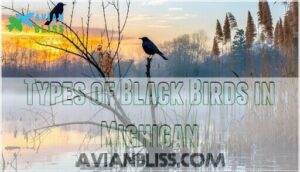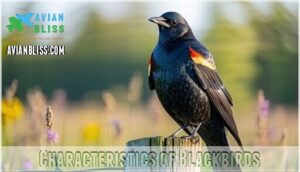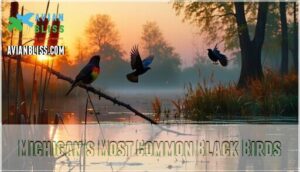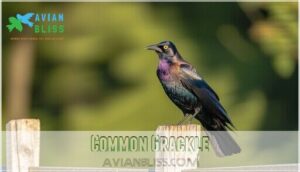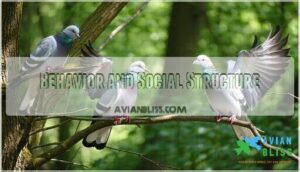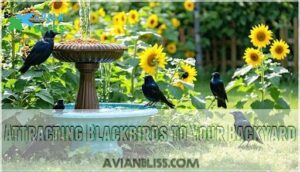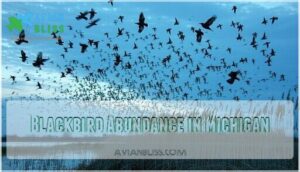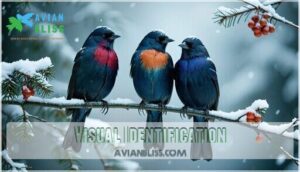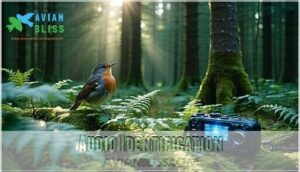This site is supported by our readers. We may earn a commission, at no cost to you, if you purchase through links.
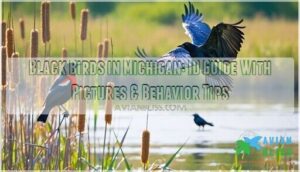
Red-winged Blackbirds flash their scarlet shoulder patches while defending marshy territories like tiny feathered bouncers. European Starlings strut around in iridescent coats that shimmer purple and green.
American Crows reign as the neighborhood’s smartest residents, solving puzzles that’d stump your average bird. Common Grackles waddle with an attitude that says they own the place.
These aren’t just pretty faces either – they’re ecological workhorses controlling pests and spreading seeds. Each species brings unique behaviors that’ll surprise you once you know what to watch for.
Table Of Contents
- Key Takeaways
- Types of Black Birds in Michigan
- Characteristics of Blackbirds
- Michigan’s Most Common Black Birds
- Behavior and Social Structure
- Attracting Blackbirds to Your Backyard
- Blackbird Abundance in Michigan
- Blackbird Identification in Michigan
- Conservation Status of Blackbirds in Michigan
- Interesting Facts About Blackbirds
- Blackbirds and The Environment
- Frequently Asked Questions (FAQs)
- Are there Blackbirds in Michigan?
- Are there black birds that resemble Hawks in Michigan?
- Where can I find blackbirds?
- Are there shiny cowbirds in Michigan?
- What is the common black bird in Michigan?
- What is the most common bird in Michigan?
- What’s the difference between a crow and a black bird?
- What birds look like crows in Michigan?
- How do blackbirds affect local crops?
- What do blackbirds eat in winter?
- Conclusion
Key Takeaways
- You’ll find at least 19 different black bird species across Michigan’s diverse habitats, from common Red-winged Blackbirds flashing red shoulder patches in wetlands to intelligent American Crows solving puzzles in your backyard.
- You can easily identify these birds by focusing on key features like males’ glossy black plumage with distinctive markings versus females’ more subdued brown coloring, plus their unique calls and behaviors that vary dramatically between species.
- You’ll attract these fascinating birds to your yard by providing fresh water sources, planting native berry bushes, leaving messy areas for insects, and understanding that some species like grackles can be aggressive around feeders.
- You’re witnessing important ecosystem players that control pest populations and disperse seeds, though some species like the Rusty Blackbird face serious conservation challenges while others like European Starlings create agricultural problems as invasive species.
Types of Black Birds in Michigan
You’ll encounter at least 19 different black bird species across Michigan’s diverse landscapes, from the flashy red-shouldered blackbirds in wetlands to the clever crows raiding your garbage cans.
These feathered residents range from year-round neighbors like Common Grackles to seasonal visitors such as the increasingly rare Rusty Blackbird that prefers Michigan’s quiet bogs and marshes.
From flashy red-winged showoffs to mysterious rusty wanderers, Michigan’s blackbirds are nature’s ultimate feathered personalities.
Common Blackbird Species in Michigan
Michigan’s common black birds are everywhere once you know what to look for. These species identification champions dominate the state’s diverse habitats, from wetlands to your backyard feeder.
Red-winged blackbirds flash their signature shoulder patches in marshy areas, while European starlings shimmer with iridescent plumage in urban settings. American crows showcase their intelligence across forests and farmlands, and common grackles strut through open woodlands with bronze-tinted feathers.
Here’s your Michigan bird identification starter pack:
- Red-winged blackbirds – wetland specialists with striking red patches
- European starlings – adaptable mimics with speckled winter coats
- American crows – clever problem-solvers with jet-black plumage
These identifying black birds thrive statewide, munching insects and seeds while adapting to habitat variation. One such species, the Brewer’s Blackbird, has the scientific name Euphagus cyanocephalus.
Less Common Blackbirds in Michigan
Not all black birds in Michigan are easy to spot, but some less common ones are worth the effort.
These species often face challenges like habitat loss and climate change, making sightings even more special.
Keep your Michigan bird guide handy for these fascinating finds:
- Eastern Meadowlark: A grassland beauty with a bright yellow chest and a bold black "V." Its flute-like song is a joy on open prairies.
- Bobolink: This quirky bird flips the tuxedo look, flaunting white on its back and black underneath. It’s a summer visitor to Michigan fields.
- Rusty Blackbird: A wetland dweller with rusty-edged feathers in winter. Their population trends are concerning, but spotting one feels like finding treasure.
These birds highlight the importance of conservation strategies and careful identification.
Rare Blackbirds in Michigan
Beyond the less common species, you’ll encounter Michigan’s truly rare vagrant blackbirds – the ultimate prize for dedicated birdwatchers.
Declining populations from habitat loss and climate change make these sightings extra special. The Rusty Blackbird faces severe population decline, while Yellow-headed Blackbirds appear sporadically near Saginaw Bay.
Boat-tailed Grackles occasionally wander north, and Black Vultures are expanding their range. Hybridization events between species create unique identification challenges.
These black birds Michigan birders dream about require patience and persistence.
Characteristics of Blackbirds
You’ll find that Michigan’s blackbirds share several key traits that make identification easier once you know what to look for.
These birds typically show strong differences between males and females, with males sporting glossy black feathers and bright patches while females wear more subdued brown colors for better camouflage.
Appearance
Plumage iridescence sets Michigan’s black colored birds apart from ordinary feathered creatures.
You’ll notice how iridescent feathers shimmer with greens, purples, and blues when sunlight hits them just right—it’s like nature’s own disco ball effect.
Sexual dimorphism means males and females look quite different.
Male Red-winged Blackbirds sport flashy red shoulder patches, while females wear subtle brown streaks.
Large black birds like Common Grackles show off bronze and purple sheens, while small black birds might appear completely matte.
Juvenile markings often confuse new birders.
Young birds typically sport streaky, brownish plumage before developing their adult colors.
Seasonal molting changes their appearance throughout the year—some darkfeathered birds grow rusty edges in winter.
Regional variations exist too.
Birds in northern Michigan might appear slightly different from their southern cousins, adapting to local conditions and food sources.
Habitat
You’ll find Michigan’s black birds thriving in surprisingly diverse environments across the state.
These adaptable species make themselves at home in various Michigan ecosystems, from pristine wetland habitats to bustling urban habitats.
Black birds choose nesting locations based on available resources and protection:
- Marshes and wetlands for Red-winged Blackbirds
- City parks and suburbs for European Starlings
- Agricultural fields for Common Grackles
- Forest edges for American Crows
Seasonal changes drive habitat shifts, while habitat loss threatens Michigan wildlife populations statewide.
Diet: Insects, Grains, and Small Mammals
Michigan’s black birds showcase remarkable dietary flexibility that keeps them thriving year-round.
Their foraging strategies adapt to whatever nature provides, making them successful survivors.
Insect consumption peaks during breeding season when protein demands soar.
Grain preference shifts with harvest cycles, while mammal predation occurs opportunistically.
This seasonal diet variation explains why you’ll see different bird feeding behaviors throughout the year.
Here’s what fuels these adaptable creatures:
- Spring protein rush: caterpillars and beetle larvae for growing chicks
- Summer buffet: grasshoppers, ants, and wild berries
- Fall harvest: corn kernels, sunflower seeds, and acorns
- Winter survival mode: dried fruits, small rodents, and backyard offerings
Fun Fact: Known for Aggressive Behavior Around Feeders
Your feeder’s about to become a wrestling ring when Michigan’s common black birds show up!
Feeder Dominance kicks in as Common Grackles and American Crows flex their territorial displays.
These species aggression tactics include wing-spreading, loud calls, and strategic positioning.
Competition tactics can overwhelm smaller birds completely.
Mitigation strategies work wonders: use multiple bird feeders spaced apart or choose feeders designed for specific bird behavior patterns to reduce conflicts.
Male Vs. Female: Identification Differences
Spotting the differences between male and female black birds in Michigan becomes easier once you know what to look for.
These Michigan birds showcase distinct identification features that’ll help you tell them apart at your feeder.
- Plumage Variation: Males typically display bolder, shinier black feathers while females wear duller, streaked brown patterns for camouflage
- Size Dimorphism: Male black bird species often appear larger and more robust than their female counterparts
- Song Differences: Males produce louder, more complex vocalizations during breeding season to attract mates
- Behavioral Roles: Males defend territories aggressively while females focus on nest-building and chick care
- Juvenile Appearance: Young birds resemble females regardless of sex until they mature
Michigan’s Most Common Black Birds
You’ll spot four main black birds across Michigan’s landscapes, from your backyard feeder to wetland marshes.
The Red-winged Blackbird, European Starling, American Crow, and Common Grackle make up the core group you’re most likely to encounter during any birdwatching adventure.
Red-winged Blackbird
You’ll easily spot Red-winged Blackbirds across Michigan’s marshes and wetlands.
Males flash bright red shoulder patches during territorial defense, while females sport streaky brown plumage for camouflage.
Their "conk-la-ree" calls echo through cattail stands where they build cup-shaped nests.
Notably, other blackbird species, like the Brewer’s Blackbird, are known for ground foraging behavior.
| Feature | Male | Female |
|---|---|---|
| Coloration | Jet black with red epaulets | Brown with heavy streaking |
| Size | 8.5 inches | 7 inches |
| Behavior | Aggressive territory defender | Secretive nest builder |
| Diet | Seeds, insects, small fruits | Similar omnivorous diet |
These adaptable birds thrive in wetland conservation areas, adjusting their diet variation seasonally while maintaining strong nesting ecology patterns throughout Michigan’s diverse habitats.
European Starling
European Starlings flood Michigan’s landscapes like feathered invaders. These black birds aren’t native—they’re an invasive species that arrived in 1890 and never left.
Nature’s disco balls with attitude problems—starlings shimmer, squawk, and steal the spotlight from every native bird in sight.
You’ll recognize their shimmery plumage and incredible mimicry abilities, copying everything from car alarms to other bird calls.
Here’s what makes starlings fascinating yet problematic:
- Starling diet includes insects, fruits, and garbage
- Invasive impact displaces native cavity-nesting birds
- Starling murmurations create spectacular winter sky displays
- Mimicry abilities let them imitate dozens of sounds
- Control methods remain challenging for homeowners
American Crow
You’ll instantly recognize American Crows by their jet-black feathers and intelligent eyes.
These corvids showcase remarkable crow intelligence through impressive tool use – they’ll bend wire to extract food!
Urban crows thrive in Michigan cities, demonstrating complex crow communication with over 20 distinct calls.
Their cultural significance spans centuries, symbolizing wisdom across cultures.
Watch these brilliant black birds in Michigan problem-solve during your next birdwatching Michigan adventure.
Common Grackle
Common Grackles strut through Michigan like feathered royalty with their grackle plumage shimmering bronze and purple.
These black birds in Michigan sport piercing yellow eyes and long tails.
Their grackle diet includes insects, seeds, and small fish from diverse grackle habitats.
Listen for their creaky grackle sounds – like rusty hinges opening.
Grackle behavior during bird watching Michigan sessions reveals intelligent, social creatures perfect for bird identification.
Behavior and Social Structure
You’ll find Michigan’s black birds display fascinating social behaviors that range from tight-knit family groups to massive winter flocks of thousands.
Understanding these patterns helps you predict where to spot different species and explains why some birds seem friendly while others act like feathered bullies at your bird feeder.
Social Behavior
Blackbirds in Michigan form complex social hierarchies that’ll amaze you.
Red-winged Blackbirds use communication signals like wing displays and calls to establish dominance.
You’ll witness impressive flocking dynamics when hundreds gather at communal roosts.
During breeding season, males perform elaborate territorial defense, chasing rivals while showing off red shoulder patches.
These Michigan bird species create sophisticated bird social behavior patterns that change with seasons.
Unique Behavior: Lays Eggs in Other Birds’ Nests
While most blackbirds in Michigan practice traditional parenting, Brown-headed Cowbirds break every rule in the book.
These brood parasites perfect the art of "reproductive freeloading" by sneaking their eggs into other birds’ nests. You’ll find these cunning black birds targeting over 220 host species across Michigan’s landscapes.
Here’s how brood parasitism works:
- Surveillance – Female cowbirds scout potential host nests
- Infiltration – Quick egg deposits when hosts aren’t watching
- Exploitation – Cowbird chicks often outcompete legitimate offspring
This evolutionary strategy transforms unsuspecting songbirds into unwilling foster parents, showcasing nature’s craftiest nest defense bypass.
Impact on Other Species
Beyond their sneaky egg-laying tactics, black birds in Michigan shake up the ecosystem in surprising ways.
Brood parasitism by cowbirds leads to bird population decline as host species struggle to raise their own young. Competition for nesting sites intensifies when aggressive blackbirds muscle out smaller species.
Predation effects ripple through ecosystems as blackbirds raid other birds’ nests for eggs and chicks. Disease spread becomes a concern when large flocks gather.
However, these feathered troublemakers aren’t all bad—they devour insects that damage crops and gardens.
| Impact Type | Effect | Example Species |
|---|---|---|
| Competition | Habitat displacement | Native songbirds |
| Predation Effects | Nest raiding | Ground-nesting birds |
| Disease Spread | Pathogen transmission | Waterfowl populations |
Vocalization: Distinctive Calls
You’ll hear black bird sounds everywhere once you know what to listen for. Each species has its own vocal signature that serves different purposes in their daily lives.
Bird vocalizations range from simple chirps to complex melodies. Song complexity varies dramatically between species, with some birds creating intricate musical phrases while others stick to basic calls.
- Call functions include territory defense, mate attraction, and flock coordination
- Alarm calls warn other birds about predators or threats nearby
- Mimicry abilities let some species copy other birds and environmental sounds
- Regional dialects create variations in the same species across different areas
- Bird calls help identify species even when you can’t see them clearly
Attracting Blackbirds to Your Backyard
You can turn your backyard into a blackbird haven by offering what these intelligent birds need most.
Create the right mix of food sources, water features, and natural habitat areas to attract Red-winged Blackbirds, Common Grackles, and other species year-round.
Planting Fruiting and Berry Plants
Transform your yard into a black birds paradise with strategic Berry Plant Selection! Elderberries, serviceberries, and native sumac create an irresistible buffet that outshines traditional bird feeders.
These hardy plants thrive in Michigan‘s climate while supporting natural bird diet needs. Consider Michigan berry cultivation for ideal growth.
Focus on Soil Preparation Tips like adding compost for drainage. Companion Planting Guide suggests pairing berries with native grasses.
Skip complex Pruning Berry Bushes initially—let nature do the work while you enjoy constant bird feeding action year-round!
Providing Fresh Water
Food brings blackbirds to your yard, but fresh water keeps them coming back.
Set up a bird bath or shallow water source 1-2 inches deep for perfect splashing. Clean it weekly to prevent algae and bacteria buildup.
In winter, use heated birdbaths to provide unfrozen water when natural sources ice over. Maintaining bird baths helps prevent bacteria buildup and keeps birds healthy.
Place your water source near shrubs for quick escape routes but visible enough for easy access. Black birds in Michigan especially appreciate consistent water sources during dry spells and migration periods.
Hanging Nectar Feeders for Orioles
With your water source ready, you’ll want to roll out the red carpet for Michigan’s flashiest visitors – orioles. These stunning black birds have an undeniable sweet tooth that’ll keep them coming back to your yard.
Baltimore Orioles arrive in Michigan around early May, and the right nectar feeder types can make your backyard their favorite pit stop.
Here’s how to create an oriole paradise:
- Mix the perfect oriole nectar recipe: 1 part sugar to 4 parts water (no red dye needed)
- Choose bright orange feeders with large perches and wide feeding ports
- Follow smart feeder placement tips: hang near trees for quick escapes
- Maintain cleaning feeder frequency: wash weekly to prevent dangerous mold
- Add orange halves or grape jelly for extra appeal
You can even find specialized products for the perfect nectar recipe. Your bird feeders will soon buzz with activity, attracting other birds while keeping these gorgeous visitors happy and healthy.
Leaving Areas of Your Yard Messy for Insects
Beyond those sweet nectar feeders, your yard’s "messy" corners become goldmines for black birds in Michigan.
Leave brush piles, fallen logs, and wildflower patches undisturbed—they’re bustling insect habitats that fuel Michigan bird species naturally.
| Messy Area Type | Insects Attracted | Birds Benefited |
|---|---|---|
| Brush Piles | Beetles, spiders | Crows, grackles |
| Log Debris | Grubs, ants | Red-winged blackbirds |
| Wildflower Patches | Flying insects | All blackbird species |
| Leaf Litter | Worms, larvae | Ground-feeding birds |
This natural pest control supports thriving yard ecosystems while creating prime bird habitats in Michigan for birdwatching enthusiasts. You can find products for insects to further enhance these habitats.
Blackbird Abundance in Michigan
You’ll find blackbirds throughout Michigan in impressive numbers, with at least 19 different species calling the state home during various seasons.
From the abundant Red-winged Blackbirds dominating wetlands to massive winter flocks of European Starlings that can darken the sky, these adaptable birds have mastered Michigan’s diverse landscapes better than most tourists master a road map, showcasing their ability to thrive in various environments with impressive numbers.
Seasonal Distribution of Blackbirds
Tracking seasonal patterns reveals how black birds in Michigan shift with nature’s calendar.
Spring arrival brings red-winged blackbirds to wetlands by March, while summer breeding creates bustling activity in marshes.
Fall migration triggers massive flocks gathering before their southward journey.
Winter roosting leaves hardy residents like starlings weathering Michigan’s cold.
Resource availability shapes these movements:
- Wetland insects fuel spring territory battles
- Abundant seeds support summer family raising
- Agricultural crops provide fall energy reserves
- Urban food sources sustain winter survivors
Migration Patterns of Blackbirds
Most black birds in Michigan are incredible navigators, using stars, magnetic fields, and landmarks as their built-in GPS systems. You’ll witness these feathered athletes tackle journeys that’d make marathon runners jealous!
Climate change is reshuffling traditional black bird migration schedules, creating new challenges for these adaptable travelers. One major threat includes collision with towers.
Migration triggers and navigation methods vary by species:
- Red-winged Blackbirds arrive in southern Michigan by mid-February, following ancient flyways
- Stopover locations include wetlands where birds refuel during their epic journeys
- Some species cover 800 miles daily during peak migration periods
- Population impact from shifting weather patterns affects timing and survival rates
Understanding bird migration patterns helps you predict when different black birds will grace your Michigan backyard.
Habitat Preferences of Blackbirds
Michigan’s black birds have mastered the art of real estate selection, each species claiming its perfect territory.
You’ll spot these adaptable creatures across diverse landscapes, from bustling cities to quiet wetlands.
Preferred Habitat Nesting Spots
These clever birds establish winter roosts in protected areas, transforming Michigan’s marshes into their seasonal headquarters.
Blackbird Identification in Michigan
You’ll find that identifying Michigan’s blackbirds becomes much easier when you know what to look for and listen for.
Most people struggle with telling these dark-feathered birds apart, but once you learn their key visual features, sounds, and behaviors, you’ll spot the differences like a pro, using your understanding of complete concepts.
Visual Identification
Spotting Michigan’s black birds becomes easier when you focus on key visual markers.
Plumage variations tell the whole story – red-winged blackbirds flash crimson shoulder patches while common grackles shimmer with iridescent blues and purples.
Size comparison helps distinguish species, and bill shape reveals feeding habits.
Here’s your visual identification toolkit:
- Plumage patterns – Look for colorful patches, stripes, or glossy sheens
- Body proportions – Compare wingspan and tail length to familiar bird species
- Habitat cues – Match the bird’s environment to likely candidates
Audio Identification
Your ears can be your best identification tool when spotting black birds in Michigan. Each bird species has unique vocal signatures that make bird identification easier than visual spotting alone.
Vocalization Analysis reveals that Red-winged Blackbirds produce their famous "conk-la-ree" trill, while Common Grackles sound like squeaky hinges.
Call Recognition helps distinguish short alarm calls from complex bird songs.
European Starlings excel at Mimicry Detection, copying other species’ sounds.
Song Complexity varies dramatically between species, making Acoustic Adaptation essential for accurate identification.
Behavioral Identification
Beyond sound cues, watching bird behavior reveals essential identification clues for Michigan’s black bird species.
These behavioral patterns help distinguish one species from another in the field.
Key behavioral identification markers include:
- Flocking Behavior – Starlings form tight murmurations while grackles move in loose groups
- Territorial Defense – Red-winged Blackbirds aggressively guard cattail perches, displaying shoulder patches
- Foraging Techniques – Cowbirds follow grazing animals, catching disturbed insects
- Mating Rituals – Males perform elaborate displays during breeding season, showcasing species-specific courtship behaviors
Conservation Status of Blackbirds in Michigan
You’ll find Michigan’s blackbirds face different conservation challenges, from the thriving Red-winged Blackbird to the declining Rusty Blackbird that’s now on the IUCN Red List.
Understanding these species’ current status helps you recognize which birds need protection and how human activities affect their populations across the state, particularly for the Rusty Blackbird.
Threatened and Endangered Blackbirds
You’ve mastered identifying these feathered friends, but some Michigan blackbirds are fighting for survival.
The Rusty Blackbird faces severe population decline, while the Black Tern earns state-threatened status.
Habitat loss and climate change create perfect storms for these struggling species.
Alarmingly, plastic pollution impacts even remote bird habitats.
| Species | Conservation Status | Primary Threats | Population Trend | Recovery Outlook |
|---|---|---|---|---|
| Rusty Blackbird | Declining | Wetland loss, invasive species | Severe decline | Uncertain |
| Black Tern | State-threatened | Habitat destruction | Declining | Requires intervention |
| Red-winged Blackbird | Stable | Agricultural changes | Stable | Good |
| Common Grackle | Stable | Urban development | Stable | Good |
| European Starling | Abundant | None (invasive) | Increasing | N/A |
The table summarizes the conservation status of various blackbird species in Michigan, highlighting the primary threats and population trends.
Conservation Efforts for Blackbirds
Through dedicated Michigan bird conservation efforts, you’ll witness remarkable habitat preservation initiatives protecting our feathered friends.
These conservation programs focus on three critical areas:
- Wetland restoration projects that create safe nesting grounds for red-winged blackbirds
- Population monitoring programs tracking species like the threatened rusty blackbird
- Invasive control measures managing European starling populations while protecting native species
State Wildlife Grants fund thorough bird conservation across Michigan’s diverse ecosystems.
Climate change adaptation strategies help black birds adjust to shifting weather patterns.
Public awareness campaigns educate communities about supporting local bird populations through backyard conservation practices.
Impact of Human Activity on Blackbirds
Looking beyond conservation efforts, you’ll see that human activities create serious challenges for Michigan’s black birds.
Habitat loss from urbanization effects shrinks their nesting areas, while agriculture impacts eliminate food sources through pesticide use.
Climate change disrupts migration patterns, forcing birds to adapt quickly or face population decline.
Your backyard choices directly influence bird conservation and population trends across Michigan’s diverse bird habitats.
You can make a difference by taking simple steps, such as planting native trees to reduce habitat loss, going organic in your garden to minimize pesticide use, and reducing your carbon footprint to combat climate change.
Interesting Facts About Blackbirds
You’ll be amazed to learn that blackbirds are some of nature’s smartest creatures, with crows able to recognize your face and remember it for years.
These feathered geniuses can solve puzzles, use tools, and even hold "funerals" when one of their own dies, proving there’s much more to these common birds than meets the eye, with feathered geniuses being a notable example of their intelligence and ability to adapt.
They exhibit complex behaviors, and their actions demonstrate a high level of intelligence.
Intelligence and Problem-Solving
While protecting these species matters, Michigan’s black birds showcase remarkable blackbird cognition that’ll blow your mind. These feathered geniuses demonstrate bird intelligence that rivals some mammals.
Crow tool use stands out among their problem-solving skills. You’ll witness Grackle adaptability as they figure out complex feeders, while Starling mimicry shows off their vocal learning abilities. Cowbird strategies for finding host nests reveal sophisticated planning skills.
Their brains also exhibit high neuron density, allowing for efficient processing.
Black birds in Michigan display impressive bird behavior through:
- Memory mapping of hundreds of food cache locations
- Multi-step puzzle solving to access treats
- Social learning from watching other birds
- Tool crafting using twigs and leaves
- Recognition of individual human faces
These brainy birds constantly surprise researchers with their clever solutions.
Complex Social Structures
Black birds in Michigan showcase fascinating flocking dynamics and dominance hierarchies that’ll surprise you.
These intelligent creatures use communication signals to maintain order within their groups, while social learning helps younger birds master survival skills.
Some species even practice cooperative breeding, where multiple adults help raise chicks.
| Behavior Type | Purpose | Example |
|---|---|---|
| Pecking Order | Establish rank | Dominant bird feeds first |
| Alarm Calls | Warn flock | Sharp chirps signal danger |
| Wing Displays | Show dominance | Spread wings to claim territory |
Bird intelligence drives these complex bird behavior patterns in bird flocks.
Unique Mating and Breeding Habits
Michigan’s types of black birds showcase fascinating mating strategies that’ll surprise you.
Redwinged Blackbirds perform elaborate nesting rituals, with males defending territories fiercely during mate selection.
Common Grackles engage in cooperative breeding, sharing parenting duties within colonies.
However, some species practice brood parasitism – cowbirds sneak their eggs into other birds’ nests, letting unwitting hosts raise their young.
Hybridization events occasionally occur between closely related species, creating unique offspring that challenge traditional identification methods.
Blackbirds and The Environment
You’ll discover that blackbirds play vital roles as both ecosystem helpers and agricultural challenges across Michigan’s landscapes.
These feathered residents control insect populations while also raiding crops, making them nature’s most complicated neighbors in your backyard, as they are nature’s most complicated neighbors.
Role of Blackbirds in Ecosystems
You’ll find black birds in Michigan playing essential roles as ecosystem engineers.
They excel at insect control, devouring crop-damaging pests by the thousands.
Through seed dispersal, they scatter native plants across wetlands and forests, creating new habitats.
Their carrion removal keeps environments clean and disease-free.
These feathered workers maintain wetland health by controlling aquatic insects and spreading marsh plants.
Within the food web, they connect various ecosystem levels, supporting ecological importance that keeps Michigan’s natural systems thriving.
Impact of Blackbirds on Agriculture
While blackbirds contribute positively to Michigan’s ecosystems, they create significant agricultural challenges through Crop Damage and Seed Consumption.
Common Grackle and Brownheaded Cowbird flocks can devastate sunflower fields, causing substantial Economic Impact for farmers.
However, their bird diets aren’t entirely problematic:
- Pest Control – consuming harmful insects that damage crops
- Natural seed dispersal – spreading beneficial plant species
- Soil aeration – improving growing conditions through ground foraging
Rusty Blackbird populations also contribute to Disease Spread management in agricultural areas.
Blackbirds as Indicators of Environmental Health
When black birds in Michigan start disappearing, it’s nature’s red flag waving.
These feathered sentinels reveal habitat loss, pollution effects, and climate change impacts before we notice.
Their sensitivity to bioaccumulation risks makes them perfect ecosystem watchdogs.
Changes in their populations signal food web disruptions and threatened bird habitats.
By monitoring these species, you’re tracking the health of entire bird ecosystems, which is essentially protecting your environmental early warning system.
Frequently Asked Questions (FAQs)
Are there Blackbirds in Michigan?
Yes, you’ll spot several blackbird species across Michigan’s diverse landscapes.
Red-winged Blackbirds dominate wetlands, while Common Grackles frequent urban areas.
You can also find European Starlings, American Crows, and the near-threatened Rusty Blackbird throughout the state.
Are there black birds that resemble Hawks in Michigan?
Turkey Vultures absolutely dominate Michigan skies with their massive wingspan and soaring flight patterns that’ll fool you every time.
You’ll spot these dark, hawk-like scavengers circling overhead, but their wobbly flight gives them away instantly, making them distinct from other birds with their soaring flight patterns.
Where can I find blackbirds?
You’ll discover these feathered friends in wetlands, marshes, grasslands, and urban parks throughout Michigan.
Look for them near cattails, open fields, suburban backyards, and agricultural areas where they forage and nest year-round.
Are there shiny cowbirds in Michigan?
Unfortunately, you won’t spot Shiny Cowbirds in Michigan’s neighborhoods.
These South American birds don’t venture into North American territories.
However, you’ll find Brown-headed Cowbirds throughout Michigan – they’re the local brood parasites causing quite the stir.
What is the common black bird in Michigan?
You’ll spot Red-winged Blackbirds most often in Michigan’s wetlands and marshes. Males flash bright red shoulder patches while females sport brown streaked feathers. They’re Michigan’s most abundant blackbird species year-round.
What is the most common bird in Michigan?
You’ll find American Robins absolutely everywhere in Michigan – they’re practically the state’s unofficial mascot! These orange-breasted beauties dominate backyards, parks, and forests, making them Michigan’s most common bird species.
What’s the difference between a crow and a black bird?
Crows are actually a type of blackbird! You’ll recognize crows by their larger size, completely black feathers, and that familiar "caw-caw" call.
Other blackbirds include grackles and red-winged varieties with different markings.
What birds look like crows in Michigan?
Ironically, Michigan’s "fake crows" outnumber real ones.
You’ll spot Common Grackles with their glossy purple sheen, European Starlings mimicking sounds, and Brown-headed Cowbirds.
Each has distinct features that separate them from true American Crows.
How do blackbirds affect local crops?
Blackbirds can damage your crops by eating seeds, fruits, and grains.
They’ll raid cornfields, sunflower patches, and berry crops.
However, they also help by consuming harmful insects that would otherwise destroy your plants, which is a beneficial aspect of having blackbirds around.
What do blackbirds eat in winter?
During winter months, you’ll find these adaptable birds switching to seeds, berries, and agricultural grains when insects become scarce.
They’ll also scavenge human food scraps and visit backyard feeders for supplemental nutrition.
Conclusion
Spotting black birds in Michigan isn’t rocket science—though sometimes their intelligence suggests otherwise.
You’ve now got the tools to identify these feathered characters strutting around your neighborhood.
Whether it’s a Red-winged Blackbird defending its turf or a clever crow solving puzzles, each species brings unique personality to Michigan’s landscape.
Keep your binoculars handy and remember: these birds are watching you just as intently as you’re watching them, which makes for a fun and intelligent experience, so Happy birding!
- https://en.wikipedia.org/wiki/Eugene_Schieffelin
- https://www.bbc.com/future/article/20191211-crows-could-be-the-smartest-animal-other-than-primates
- https://www.iucnredlist.org/
- https://avibase.bsc-eoc.org/checklist.jsp?region=USmi&list=howardmoore
- https://naturecenter.org/wp-content/uploads/2022/05/MBBA-BOOK2.pdf

